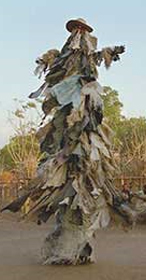MALAWIAN
CULTURES AND TRADITIONS
Malawi prides itself on a mosaic of unique cultural practices and norms. The main traditional dances and rituals as well as arts and crafts found among the people act as an identifying factor for the many but united ethnic groups of the country. The dances of Malawi, for instance, have deeper meaning than what appears on the surface and, accordingly, efforts have been made to keep these intact as part of Malawi's cultural heritage and for posterity. As a way of achieving the goal of retaining the country's traditional values, the Museum of Malawi conducts a series of cultural activities in schools and public places so that those who do not have contact with village life can benefit from facilities offered by the organization.
LANGUAGE
There are three major
languages in Malawi: Chichewa,
Chitimbuka and Chiyao—all from the
Bantu language group. The most
common is Chichewa, the language of
the Chewa tribe. Chichewa is taught
to all students in elementary school
and is unofficially recognized as
the national language of Malawi.
Chitimbuka is the language of the
Timbuka tribe largely spoken in
north Malawi, although some Timbuka
along the lakeshore speak Chitonga.
Chiyao is spoken by the Yao tribe,
who reside along the southern
lakeshore. English is an official
language of business, higher
education and government and is
widely spoken, especially in towns
and major cities.
RELIGION
Christianity was first introduced to Malawians by David Livingstone and other missionaries who worked along the lakeshore in the late 1800's and holds the largest following. Christianity spread rapidly under British colonialism despite an initially hostile welcome. Now most villages have a mission or an extension of some Christian sect. Services are in the local language in all areas and areas with large populations of expatriates may offer services in English, but increasingly services in urban areas are conducted in both English and Chichewa.
The second most
prominent religion in Malawi is
Islam—Muslims make up 15-20% of the
population. Islam was introduced by
Arab slave traders who traveled
largely by boat. They reached Malawi
via the lake in the early 1800’s,
and converted tribes along the
lakeshore. The people of the Yao
tribe along the southern lakeshore
are most strongly associated with
Islam. Almost every village in the
areas of Balaka, Machinga, and
Mangochi have a mosque. Many women
in these areas wear veils that cover
their heads, but not their faces,
and some boys learn Arabic and
Kiswahili to pursue study of the
Koran.
 DANCES
DANCES
Perhaps the oldest form of music and dance in Malawi comes from the Gule Wamkulu religion (Gule Wamkulu basically means "the big dance").
Gule Wamkulu literally translated "the big dance" is both a secret cult and ritual dance practiced among the Chewa people living in Malawi, Zambia, and Mozambique. It is performed by members of the Nyau brotherhood, which is a secret society of initiated Chewa men. The Nyau at some time believed that they could communicate with the world of the dead or spirits; this act was called 'pemphero lalikulu'. Within the Chewa's traditional matrilineal society, husbands played a rather marginal role so that the
Nyau offered a means to establish some kind of counterweight and solidarity among men of various villages.
Nyau members are responsible for the initiation of young men into adulthood, and the performance of the
Gule Wamkulu at the end of the initiation procedure is done to celebrate the young men's integration into adult society. There are over 150 Gule Wamkulu characters, each with a specific story and purpose.
 Gule
Wamkulu is performed in the season
following the harvest in July,
accompanying initiation ceremonies
but also weddings, funerals, and the
installation or the death of a
chief. On this occasion, the Nyau
dancers wear costumes and masks made
of wood and straw, representing a
great variety of characters, such as
wild animals, spirits of the dead,
slave traders, British colonialists,
white missionaries as well as more
recent figures such as the honda
or the helicopter.
Gule
Wamkulu is performed in the season
following the harvest in July,
accompanying initiation ceremonies
but also weddings, funerals, and the
installation or the death of a
chief. On this occasion, the Nyau
dancers wear costumes and masks made
of wood and straw, representing a
great variety of characters, such as
wild animals, spirits of the dead,
slave traders, British colonialists,
white missionaries as well as more
recent figures such as the honda
or the helicopter.
Each of these
figures plays a particular, often
evil, character representing certain
forms of misbehavior in order to
teach moral and social values to the
audience. These figures perform
dances and artistic movements with
extraordinary energy, partly
entertaining and partly scaring the
audience as representatives of the
world of the spirits and the dead.
Mask carvers may either be
professional or occasional artisans.
There is evidence
that Gule Wamkulu existed
during the great Chewa Empire of the
17th century. Despite the efforts of
Christian missionaries to ban this
practice in Chewa communities, it
managed to survive under British
colonial rule by adopting some
aspects of Christianity. Nowadays,
even if the matrilineal system has
lost its social significance,
Nyau societies, and with it
Gule Wamkulu, are still very
much alive and Chewa men
tend to be both members of a
Christian church and a Nyau
society.
Another popular
form of dance practiced in the
villages is Chitalele. Chitalele is
mostly performed for entertainment
on full-moon nights by young girls,
but also is used as a form of
inter-village competition. Teams of
girls travel to neighboring villages
to see which village has more
talented dancers. Unlike Gule
Wamkulu, which is mostly performed
to percussion accompaniment,
Chitalele involves call-and-response
songs and syncopated hand clapping
performed by the dancers. Dances
might call for participants to
perform various movements in unison,
or center around a pair or
individual performing in the center.